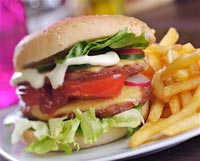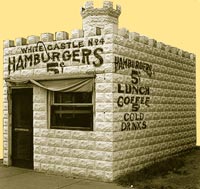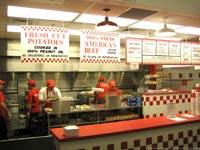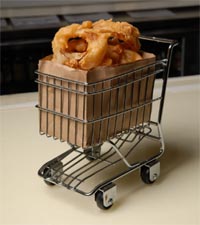
Vol. IX, No. 7, August 2009
- Editor's corner
- Social media pays
- The future of leisure time; a new value equation
- The iconic hamburger/cheeseburger goes premium
- Business death spiral!
- Foundations Entertainment University, Oct. 6-8, Dallas, Texas
- BellaBoo's opens Sept. 15
- Vicki Stoecklin featured in two magazines
- Put your business correctly on the map
- 100 flavors in new Coca-Cola soda machine
- How Americans spent their time in 2008
- Chuck E. Cheese's reports 2nd quarter results
- New clients
The iconic hamburger/cheeseburger goes premium
Nearly 125 years after the invention of the hamburger, this icon of American sandwiches is more popular than ever. Find out which chains are trying to teach an old sandwich some new tricks to take it upscale. Mustard and ketchup, watch out!
 When it comes to icons of American food, the hamburger/cheeseburger is king. When in doubt about what to eat, many Americans fall back on ordering a burger and fries. And according to the 20th Annual Weber GrillWatch Survey, hamburgers are the top choice for backyard grill fare among 69% of American grill owners.
When it comes to icons of American food, the hamburger/cheeseburger is king. When in doubt about what to eat, many Americans fall back on ordering a burger and fries. And according to the 20th Annual Weber GrillWatch Survey, hamburgers are the top choice for backyard grill fare among 69% of American grill owners.
There is disagreement on who invented the hamburger, but the year was definitely 1885. The competing claims:
 1920s White Castle |
Frank and Charles Menches, Buffalo Fair (now the Erie County Fair), Hamburg, New York. The hamburger, as the story goes, was born when the Ohio brothers, who traveled to fairs around the nation, ran out of sausage for their regular sandwich. When a local butcher couldn’t serve up replacement sausage, the brothers instead accepted ground beef. The Menches added spices, “including coffee beans and brown sugar, and other ingredients that remain a secret, except for the Menches brothers and family.”
Charles “Hamburger Charlie” Nagreen, 15, a vendor at the 1885 Seymour Fair in Wisconsin. After no luck selling meatballs, he had an idea. Knowing visitors to the fair would be hungry after gazing at the exhibits, but wouldn't be able to walk and eat at the same time, he smashed a meatball and placed it between two slices of bread. His idea was a success and he returned every year until his death in 1951. The name “hamburger” came from “Hamburg steak,” or ground beef. Since this was a popular item in Seymour at the time of the 1885 fair, Nagreen decided to call the sandwich the “Hamburger.”
 Five Guys Burgers and Fries |
Hamburgers popularity in fast food restaurants started in 1921 at a Wichita, Kansas, White Castle restaurant, where they sold 2.5-inch square hamburgers called sylders. Since then hamburgers in restaurants have diversified into many different niches, from the fast food burger joints like McDonald’s and Burger King to renowned chefs offering them on upscale menus.
 Blanc Burgers + Bottles, a gourmet hamburger restaurant chain in Kansas City, serves their onion rings and Idaho or sweet potato fries in mini-shopping carts |
Now, a whole slew of second generation premium burger restaurants are spreading throughout the country. They offer a pricier version as their mainstay item, with hand-made patties from fresh ground beef selling for $5 to $10. One of the fast-growing chains is Five Guys Burgers and Fries. Founded in 1986, it now has more than 300 locations. There’s also California-based Fatburger, Florida-based Evos, Canyons Burger Company based in Atlanta and West Coast, Burgerville. Smashburger and The Counter, a California-based chain that has spread to the East Coast, claims to offer more than 312,000 combinations of burgers, buns and fixings. (See our article in last month’s eNewsletter for more about mass customization.)
These and a number of other new chains are not the first to take the burger up a notch. Fuddruckers started in 1980 and the Red Robin Gourmet Burger chain started in 1969. Both have built their reputations on a gourmet burger.
Last year, limited-service hamburger restaurants sales rose 4.1% to $64 billion, according to Technomic. Darren Tristano, Technomic executive vice president, attributes the growth to the diversification of the traditional chains — McDonald’s, Burger King and Wendy’s — into chicken sandwiches, salads and breakfast fare. He said this has left an opening for a better burger category to emerge, focusing on a premium burger. Tristano said, “I don’t think it is anywhere near a saturation point. In fact, it’s probably five more years of good growth before you even begin to see it flatten.” Smashburger chairman David Prokupek calculates that hamburgers are an annual $100 billion category and he projects that the ‘better burger’ segment could end up capturing 30% of that market.
Vol. IX, No. 7, August 2009
- Editor's corner
- Social media pays
- The future of leisure time; a new value equation
- The iconic hamburger/cheeseburger goes premium
- Business death spiral!
- Foundations Entertainment University, Oct. 6-8, Dallas, Texas
- BellaBoo's opens Sept. 15
- Vicki Stoecklin featured in two magazines
- Put your business correctly on the map
- 100 flavors in new Coca-Cola soda machine
- How Americans spent their time in 2008
- Chuck E. Cheese's reports 2nd quarter results
- New clients


